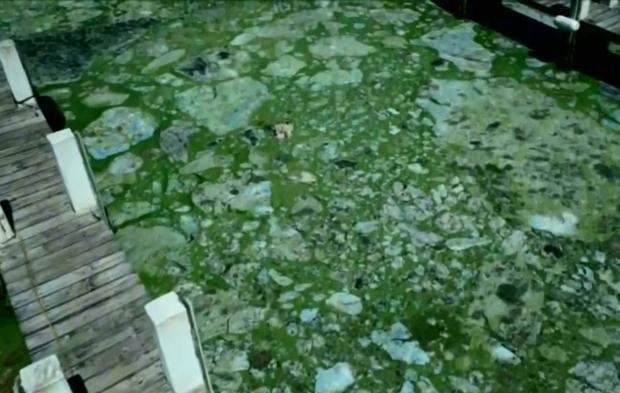Blue-Green Algae Bloom Found In Florida's Lake Okeechobee
PORT MAYACA, Fla. (CBSMiami) — Harmful blue-green algae appears to be blooming on Florida's Lake Okeechobee, according to the state's Department of Environmental Protection.
A state water management crew discovered the bloom Wednesday near the Port Mayaca Lock and Dam in western Martin County.
According to a DEP weekly report, satellite imagery also shows the algae mostly on the western portions of the lake, with medium-to-high bloom potential reported north and east of Clewiston. Newer images also show it in the northern part of the lake.
U.S. Army Corps of Engineers lock operators also have reported blue-green algae in the Caloosahatchee River, west of the lake, and at Port Mayaca on the lake's eastern side.
Audubon Florida scientist Paul Gray tells Treasure Coasts Newspapers that the new bloom is something to be concerned about, but it's "too soon to freak out."
A sample was sent to the Florida Department of Environmental Protection to test for toxins that can cause nausea and vomiting if ingested.
The algae, also known as cyanobacteria, spill into rivers, canals and estuaries south of the lake when the Corps discharges large amounts of water to prevent the Herbert Hoover Dike from being compromised.
Last summer, water released from the lake carried blankets of algae to Gulf and Atlantic waterways creating the worst blue-green algae bloom in the state's history. Bright green frothy gunk choked the rivers, fouled beaches and killed fish and marine mammals.
This year, the Army Corps is allowing water levels in Lake Okeechobee to drop lower than usual. Lower levels means the lake can hold more water during rainy season.
Blue-green algae blooms take place when heavy rains wash nutrients, such as nitrogen and phosphorus that often come from fertilizers, into the lake.
Some cyanobacteria produce toxins that in humans can cause gastrointestinal problems or liver damage. Some toxins affect the nervous system and can cause respiratory distress and eye irritation. Others can cause skin irritation.
Last summer's blue-green algae blooms were coupled with a devastating red tide outbreak along the state's beaches that caused respiratory irritations in people and killed sea turtles, manatees, dolphins and fish.
When toxic blue-green algae shut down beaches and businesses on the Treasure Coast in 2016, it prompted a political and economic crisis throughout the state.
CBS4 News spent a year tracking the causes of the algae bloom and how the ensuing debate pitted hard-pressed communities against one another.
Watch the entire Alfred I. duPont-Columbia University Award winning documentary here:
The state's bloom response team encourages everyone to be on the lookout for blooms and report them. Residents statewide can report algal blooms to the department 24 hours a day, 7 days a week. Information can be reported online through www.reportalgalbloom.com, as well as through a new toll-free number at 1-855-305-3903.
To report fish that are either dead or in poor physical condition, residents should contact the Fish Kill Hotline 1-800-636-0511.
People experiencing symptoms or illnesses should contact the Florida Poison Control Center at 1-800-222-1222.




